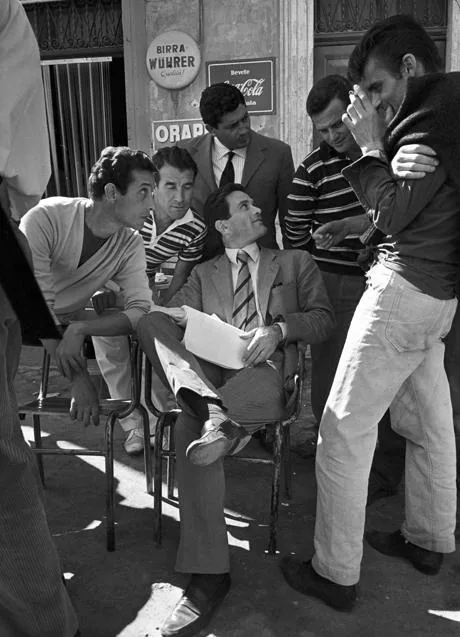Pushing society to the limit
A hundred years after his birth, the artistic legacy of Pier Paolo Pasolini is almost as vast as it is unbearably free and provocative
antonio m. ruiz
Wednesday, 18 May 2022, 14:16
Poet, revolutionary, theorist, intellectual, filmmaker, actor and expert in the dark side of the human soul, but also confessed homosexual, communist and Catholic. Pasolini stands out as one of the most forceful and illustrious scourges of the rigid Italian society of the second half of the 20th century. During his life he embraced Christianity only to later reject it, he felt defrauded by communism and Christian Democracy and found his evasion from reality in football.
The literary work of Pier Paolo Pasolini, who published his first book of verse in 1941, covers a wide range of genres, such as poetry, essays and drama. But it is through his work in film that the artist shapes his battering ram against the social stagnation that surrounds him.

Poet, intellectual, filmmaker, actor, but also confessed homosexual, communist and Catholic
After working with filmmakers of the calibre of Fellini (he was responsible for the dialogues in Nights of Cabiria) and Bertolucci (scriptwriter in The Grim Reaper), his work as a writer continues through his experimentation with film language. In both areas he shows the characteristics of someone demanding, dissatisfied, rich in contradiction. His films are the fruit of attentive and meticulous analysis of himself and his everyday reality. The first feature-length films he makes, Accattone (1961) and Mamma Roma (1962), are influenced by Italian neorealism.
The first shows the process of deterioraton of the pimp who gives his name to the title, a loathsome and despicable character who later tries to redeem himself, in an attempt to live a more decent life after spending his time exploiting two prostitutes. One of the most significant moments of the film is when Accatone asks the gravedigger to bury him in a place that gets sunlight. This religious orientation continues in Mamma Roma, in which Anna Magnani plays a prostitute mother with a rebellious son on the outskirts of Rome.
His second phase is marked by two very controversial films, key to the understanding of his work as a whole: The Gospel According to St. Matthew (1964), Silver Lion in the Venice Film Festival, and The Hawks and the Sparrows (1966). Both accentuate the author’s contradictions: communism, Catholicism and a formal experimentation linked to his personal ghosts. In particular, The Gospel According to St. Matthew, according to Pasolini’s own statements, aimed to show the figure of Christ “as a popular myth seen through the eyes of a faithful people”. It is perhaps the best approximation to the figure of the Son of God to date. Meanwhile comedy is the genre that floods The Hawks and the Sparrows, in which Chaplinian and Fellinian reminiscences mark the dialogues between two friars, father and son, and a raven.
Later the films of Pasolini focus on the analysis of the myths on which our western culture is built; this is what he sets out to do in Oedipus Rex (1967) , the most autobiographical work of his career, which does not escape the shadow of Freudian psychoanalysis. It reflects, on one hand, on a personal vision of the author’s feelings, and on the other, a representation of incestuous sexual relationships. Medea (1969), starring the soprano Maria Callas, marked a turning point in Pasolini’s artistic curiosity; the filmmaker uses Euripides’ tale to confront the idealised vision of past civilisations and the rationalist vision of modern ones. Also worth mentioning is Theorem (1968) which came at the peak of his career. An Italian middle-class family receives the visit of a mysterious guest who changes the behaviour of all its members, seducing them with his magnetic appeal, except the maid, who becomes an “apostle of the revolution”. The theatres where the film was screened were violently evacuated by police.
Also in 1969 he directed Pigsty, a cruel vision of physical and psychic cannibalism and zoophilia. He tells two stories at the same time: the first, set at the end of the 15th century, tells of a young man with an insatiable appetite which leads him to murder lone travellers, devouring them later. The second is set in Germany, at the end of the 1960s; Julian prefers his secret visits to pigsties above the love of his fiancée Ida. As can be imagined, the film was not popular and suffered generalised social rejection.
However where his reflections on sex and pleasure are more patent is in the Trilogy of Life: Decameron (1970), The Canterbury Tales (1972) and A Thousand and One Nights (1974). Pasolini used his poetical and lyrical vision of reality to promote the joy of sex. The stories, played by non-professional actors, take place in the three films with humour and irreverence, marked always by the human condition.
His last film, Salò, or The 120 Days of Sodom (1975), is based on the text of Marquis of Sade, but set in the Fascist Republic of Salò. The film focuses on a closed and evil universe where sex is a means of oppression and death in the hands of the representatives of power. It was banned in several countries.
On 2 November 1975, before the release of Salò, Pasolini died on a beach in Ostia. Even today there are several conspiracy theories that differ from the official version, which says that he lost his life at the hands of a male prostitute, Giuseppe Pelosi. However, three decades later Pelosi declared his innocence, blaming three people, who he said killed him shouting “dirty communist, poof”.

A staunch defender of “poetry film”, characterised by its symbolism and heavy literary load, 100 years after his birth in Bologna, Pasolini’s artistic legacy is almost as vast as it is unbearably free and provocative, finding its limits only in his own obsessions.



